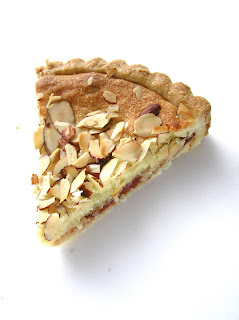Medovik Torte
European Foods, $7.49/lb
Although honey, sugar, and "sweetener" sit side-by-side on most coffee shop counters, each flavor represents such a different stage of human history that a book I'm reading distinguishes between the Ages of Honey, Sugar, and Science.
The use of honey predates written history, and versions of honey cake are known from ancient Greece and Egypt. In many parts of Europe, the baking of honey-rich breads and cakes was first associated with religious communities and then with regulated guilds. In the middle ages in Slovenia, artisan bakers specialized in honey cake, and their daughters' dowries were barrels of cake dough with a 30-year shelf life.
With the arrival of industrialization, sugar took a big slice out of honey's market share, but areas of eastern Europe have seen a recent revival of honey-infused foods. The Czech or Slovakian medovnik is a decorated sweet bread, often heart-shaped and given as a sentimental gift. The Polish miodownik or Russian medovik torte is sophisticated party fare; thin cakes of honey sponge spackled together with creamy caramel frosting and flocked with a fuzzy layer of its own crumbs.
What these cakes have in common with each other and with those barrels of Slovenian dough is a remarkable longevity, thanks to honey's humectant and anti-bacterial properties. Decorated medovnik bread harden into long-lasting decorations while mature medovik torte develops a richer flavor and more delicate texture--allowing Seattle's European Foods to import perfectly edible cake all the way from an East Coast bakery.


































